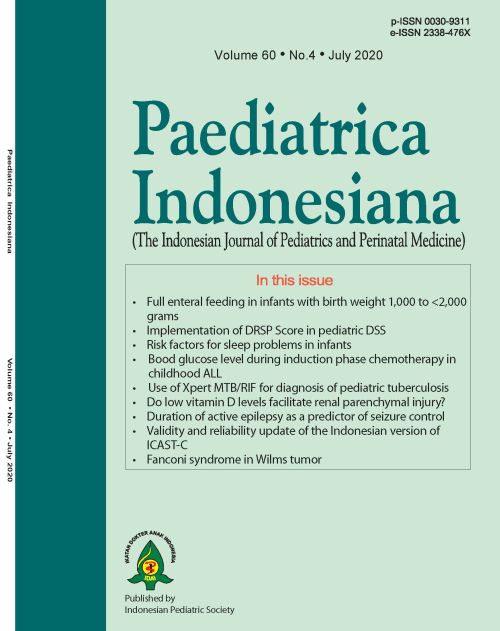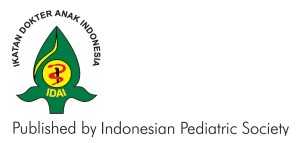Risk factors for sleep problems in infants
Abstract
Background Sleep disorders in infants can cause developmental problems, suboptimal growth, behavioral disorders, fatigue, irritability, impulsiveness, and poor mother-infant bonding.
Objective To evaluate possible risk factors for sleep disorders in infants.
Methods This cross-sectional study was conducted in healthy infants aged 3-6 months. Subjects were selected using proportional random sampling from four different primary healthcare facilities in Manado, North Sulawesi. Their parents completed the Brief Infant Sleep Questionnaire. Sleep disorder was defined as the presence of one or more conditions including sleep duration less than 9 hours at night (from 19.00 until 07.00), waking up at night (from 22.00 until 06.00) more than 3 times, and more than 1 hour waking at night.
Results Of 112 subjects, 58 (51.8%) were male. Subjects’ mean age was 4.21 (SD 0.829) months and 76 (67.86%) experienced sleep disorders. Sleep disorders had significant associations with low socioeconomic status (OR 17; 95%CI 3.8 to 75.8), middle school or lower maternal education (OR 44.5; 95%CI 9.8 to 202), non-supine sleeping position (OR 8.8; 95%CI 1.9 to 39.7), parental use of electronic devices (OR 156.2; 95%CI 35.1 to 692.9), and non-exclusive breastfeeding (OR 85.2; 95%CI 21.1 to 344.2). Correlative analyses also revealed that electronic media usage had the strongest association with sleep disorders, followed by breastfeeding pattern, maternal education, socioeconomic status, and sleeping position ( 0.839, 0.771, 0.624, 0.433, and 0.309, respectively). However, there were no significant correlations upon multivariate analysis.
Conclusion Parental use of electronic media before sleeping is the strongest risk factor for sleep disorders among infants, followed by non-exclusive breastfeeding pattern, low maternal education, low socioeconomic status, and non-supine sleeping position. However, none of these correlations were significant upon multivariate analysis, this show that all these factors influence sleep together
References
El-Sheikh M, Sadeh A. Sleep and development: introduction to the monograph. Monogr Soc Res Child Dev. 2015;80:1-14. DOI: 10.1111/mono.12141.
Bernier A, Matte-Gagne C, Bouvette-Turcot AA. Examining the interface of children’s sleep, executive functioning, and caregiving relationships: a plea against silos in the study of biology, cognition, and relationships. Curr Dir Psychol Sci. 2014;23:284-9. https://doi.org/10.1177%2F0963721414534852.
Bruni O, Baumgartner E, Sette S, Ancona M, Caso G, Di Cosimo ME, et al. Longitudinal study of sleep behavior in normal infants during the first year of life. J Clin Sleep Med. 2014;10:1119-27. https://doi.org/10.5664/jcsm.4114
Mindell JA, Lee C. Sleep, mood, and development in infants. Infant Behav Dev. 2015;41:102–7. doi: 10.1016/j.infbeh.2015.08.004.
Hysing M, Harvey AG, Torgersen L, Ystrom E, Reichborn-Kjennerud T, Sivertsen B. Trajectories and predictors of nocturnal awakenings and sleep duration in infants. J Dev Behav Pediatr. 2014;35:309-16. doi: 10.1097/DBP.0000000000000064.
Sadeh A, Tikotzky L, Scher A. Parenting and infant sleep. Sleep Med Rev. 2010;14:89-96. https://doi.org/10.1016/j.smrv.2009.05.003.
Tikotzky L. Parenting and sleep in early childhood. Curr Opin Psychol. 2017;15:118-24. https://doi.org/10.1016/j.copsyc.2017.02.016
Sekartini R, Adi NP. Gangguan tidur pada anak usia bawah tiga tahun di lima kota di Indonesia. Sari Pediatri. 2006;7:188-93.
Bathory E, Tomopoulos S. Sleep regulation, physiology and development, sleep duration and patterns, and sleep hygiene in infants, toddlers, and preschool-age children. Curr Probl Pediatr Adolesc Health Care. 2017;47:29-42. https://doi.org/10.1016/j.cppeds.2016.12.001.
Allen SL, Howlett MD, Coulombe JA, Corkum PV. ABCs of sleeping: a review of the evidence behind pediatric sleep practice recommendations. Sleep Med Rev. 2016;29:1-14. https://doi.org/10.1016/j.smrv.2015.08.006.
Touchette E. Factors associated with sleep problems in early childhood. In: Tremblay RE, Boivin M, Peters RDeV, eds. Petit D, topic ed. Encyclopedia on Early Childhood Development [online] [cited 2019 02 22]. Available from: http://www.childencyclopedia.com/documents/TouchetteANGxp1.pdf.
McDowall PS, Galland BC, Campbell AJ, Elder DE. Parent knowledge of children’s sleep: a systematic review. Sleep Med Rev. 2017;31:39-47. https://doi.org/10.1016/j.smrv.2016.01.002
Iwasaki M, Iwata S, Iemura A, Yamashita N, Tomino Y, Anme T, et al. Utility of subjective sleep assessment tools for healthy preschool children: a comparative study between sleep logs, questionnaires, and actigraphy. J Epidemiol. 2010;20:143-149. https://doi.org/10.2188/jea.JE20090054
Sadeh A. A brief screening questionnaire for infant sleep problems: validation and findings for an internet sample. Pediatrics. 2004;113:570-7. https://doi.org/10.1542/peds.113.6.e570
Field T. Infant sleep problems and interventions: a review. Infant Behav Dev. 2017;47:40–53. https://doi.org/10.1016/j.infbeh.2017.02.002
Sadeh A, Mindell JA, Luedtke K, Wiegand B. Sleep and sleep ecology in the first 3 years: a web-based study. J Sleep Res. 2009;18:60-73.
Mindell JA, Sadeh A, Wiegand B, How TH, Goh DYT. Cross cultural differences in infant and toddler sleep. Sleep Med. 2010;11:274-80. https://doi.org/10.1016/j.sleep.2009.04.012
Simard V, Chevalier V, Bedard MM. Sleep and attachment in early childhood: a series of meta-analyses. Attach Hum Dev. 2017;19:298-321. https://doi.org/10.1080/14616734.2017.1293703
Ammari A, Schulze KF, Ohira-Kist K, Kashyap S, Fifer WP, Myers MM, et al. Effects of body position on thermal, cardiorespiratory and metabolic activity in low birth weight infants. Early Hum Dev. 2009;85:497-501. https://dx.doi.org/10.1016%2Fj.earlhumdev.2009.04.005
Twenge JM, Hisler GC, Krizan Z. Association between screen time and sleep duration are primarily driven by portable electronic devices: evidence from a population-based study of U.S. children agaes 0-17. Sleep Med. 2019;56:211-8. https://doi.org/10.1016/j.sleep.2018.11.009.
Chang AM, Aeschbach D, Du JF, Czeisler CA. Evening use of light-emitting eReaders negatively affects sleep, circadian timing, and next-morning alertness. Proc Natl Acad Sci USA. 2015;112:1232–7. https://doi.org/10.1073/pnas.1418490112.
Carter B, Rees P, Hale L, Bhattacharjee D, Paradkar MS. Association between portable screen-based media device access or use and sleep outcomes: a systematic review and meta-analysis. JAMA Pediatr. 2016;170:1202-8. doi:10.1001/jamapediatrics.2016.2341.
Engler AC, Hadash A, Shehadeh N, Pillar G. Breastfeeding may improve nocturnal sleep and reduce infantile colic: potential role of breast milk melatonin. Eur J Pediatr. 2012;171:729–32. https://doi.org/10.1007/s00431-011-1659-3.
Copyright (c) 2020 Hesti Lestari, Sp.A(K), Audrey MI Wahani, Sp.A(K), Rocky Wilar, Sp.A(K), Permatami Herwansyah, Sp.A

This work is licensed under a Creative Commons Attribution-NonCommercial-ShareAlike 4.0 International License.
Authors who publish with this journal agree to the following terms:
Authors retain copyright and grant the journal right of first publication with the work simultaneously licensed under a Creative Commons Attribution License that allows others to share the work with an acknowledgement of the work's authorship and initial publication in this journal.
Authors are able to enter into separate, additional contractual arrangements for the non-exclusive distribution of the journal's published version of the work (e.g., post it to an institutional repository or publish it in a book), with an acknowledgement of its initial publication in this journal.

This work is licensed under a Creative Commons Attribution-NonCommercial-ShareAlike 4.0 International License.
Accepted 2020-07-20
Published 2020-07-20












